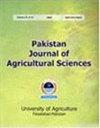A novel and high throughput wheat (Triticum aestivum L.) genotyping using Kompetitive Allele Specific PCR assay for genes underpinning major economic attributes
IF 0.6
4区 农林科学
Q3 AGRICULTURE, MULTIDISCIPLINARY
引用次数: 0
Abstract
Wheat breeding programs are increasingly using molecular tools to improve efficiency and speed of developing productive cultivars. Molecular markers such as Kompetitive Allele Specific PCR (KASP) have now become a principal approach to study genetic relationship among various wheat species. The objective of our research study was to identify and distinguished the wheat parents and their hybrid for genes controlling major agronomical attributes. Germplasm comprised of fifteen genotypes were genotyped for gluten strength (Glu A1, Glu D1), height reduction (Rht 1), starch quality (Waxy), vernalization (Vrn A1, Vrn B1), photoperiod sensitivity (Ppd 1), Tan spot disease (Tns-1) and leaf rust disease (Lr34). Statistical analysis with endpoint genotyping, graphical display and principal coordinate revealed significant results for KASP assay. Most variable crosses were S3 X I1, S3 X I3, S2 X I1, S2 X I2 and S1 X I1 with maximum segregants. Whereas, variation was observed for Glu-D1, Tsn1, Glu-A1 followed by Lr34 alleles. Therefore, the objective was achieved successfully with the most reliable KASP markers. The diverse attributes dissected, and key hybrids identified in this study would provide guidance for the improvement of the economically important traits and provide understanding of genetic variability in distinct segregating populations. Besides we have identified significantly important partial mutants in the germplasm for Waxy allele. These findings could provide the end user with wheat products with improved quality such as with or without amylose content.利用竞争性等位基因特异性PCR方法对小麦主要经济属性基因进行分型
小麦育种计划越来越多地使用分子工具来提高生产品种的开发效率和速度。分子标记如竞争等位基因特异性PCR(KASP)已成为研究不同小麦品种间遗传关系的主要方法。本研究的目的是鉴定和区分小麦亲本及其杂交种的主要农艺性状控制基因。对由15个基因型组成的种质进行了谷蛋白强度(Glu A1、Glu D1)、高度降低(Rht1)、淀粉品质(Waxy)、春化(Vrn A1、Vrn B1)、光周期敏感性(Ppd 1)、斑点病(Tns-1)和叶锈病(Lr34)的基因分型。终点基因分型、图形显示和主坐标的统计分析显示KASP测定的显著结果。大多数可变杂交为S3 X I1、S3 X I3、S2 X I1,S2 X I2和S1 X I1。而Glu-D1、Tsn1、Glu-A1和Lr34等位基因则存在变异。因此,使用最可靠的KASP标记成功实现了该目标。本研究中分析的不同属性和确定的关键杂交种将为改善经济上重要的性状提供指导,并提供对不同分离群体遗传变异性的理解。此外,我们已经在Waxy等位基因的种质中鉴定了显著重要的部分突变体。这些发现可以为最终用户提供具有改进质量的小麦产品,例如具有或不具有直链淀粉含量。
本文章由计算机程序翻译,如有差异,请以英文原文为准。
求助全文
约1分钟内获得全文
求助全文
来源期刊

Pakistan Journal of Agricultural Sciences
AGRICULTURE, MULTIDISCIPLINARY-
CiteScore
1.80
自引率
25.00%
发文量
18
审稿时长
6-12 weeks
期刊介绍:
Pakistan Journal of Agricultural Sciences is published in English four times a year. The journal publishes original articles on all aspects of agriculture and allied fields.
 求助内容:
求助内容: 应助结果提醒方式:
应助结果提醒方式:


